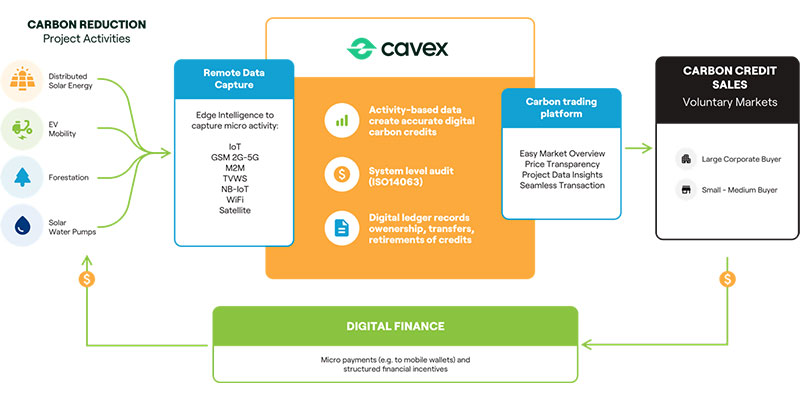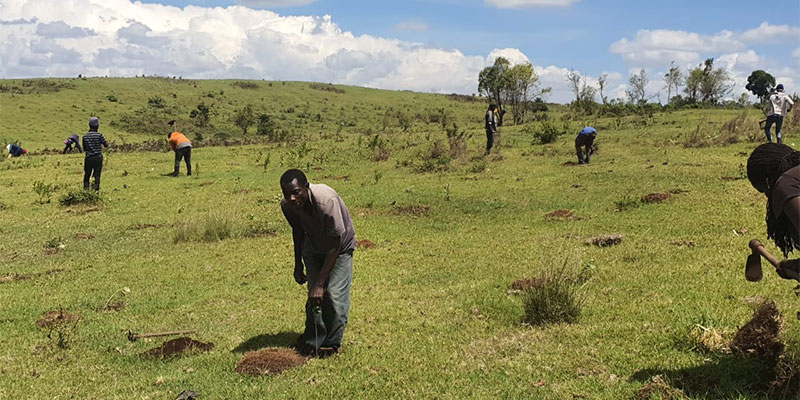Increasing climate commitments create demand for carbon credits
A growing number of organisations want to contribute positively to meeting the challenge of climate change and many are doing this by setting a carbon net zero goal. For example 38 per cent of the Global Fortune 500 have committed to becoming net zero by 2030-2050. These companies will need to reduce their carbon footprint to zero primarily by cutting emissions, while also offsetting by buying carbon credits from projects that remove or displace carbon emissions (such as reforestation and solar power projects).
Current challenges in carbon markets
Carbon credit buyers must ensure that the credits that they buy are legitimate, so that they can count them against their net zero targets. The lack of a transparent central marketplace and the heavy overhead costs of project verification have restricted the growth of carbon markets. Typically, only large-scale projects have qualified and most trades are made over-the-counter, project-by-project. Many small-scale climate positive initiatives are excluded from the market and have no way of accessing climate financing despite their positive environmental and social impacts.
Carbon Value Exchange (CaVEx) – a new digital market platform
4R Digital is developing the Carbon Value Exchange (CaVEx) platform that monetises carbon reduction and sequestration activities from a range of micro-small projects. Using technology advancements in remote sensing, device connectivity (the “Internet of Things”, or “IoT”) and digital payments, the platform will enable micro-small projects to be rewarded for reducing or removing carbon emissions in a highly transparent, auditable and fair way. The overarching objective of CaVEx is to use available technologies to reduce the costs of collecting project related data without compromising quality. Also lowering the cost of validation and enabling more value from the sale of credits to flow back to the originating projects, communities and individuals. The use of technology offers considerable efficiency gains, as well as providing great transparency in real-time, including micro-payments to individuals as required.
The CaVEx platform is initially being designed around four climate positive use-cases (all live projects underway in Sub Saharan Africa). The use-cases include: electric-mobility; solar water pumps; distributed solar power; and reforestation. Each use-case has unique data reporting requirements that capture activities completed. These data requirements will be set by independent validation experts to ensure that the data is based on science and precedents already established in calculating carbon reductions or emissions (for example under the Clean Development Mechanism).

Supporting community led reforestation with Safaricom
The reforestation use-case is a community-led initiative managed by the Kenya Forest Service (KFS) in collaboration with Safaricom and the GSMA. Safaricom is Kenya’s largest mobile network operator and has committed to reducing its carbon footprint and becoming a net zero company by 2050. Since 2018, Safaricom has been working with its partners to plant five million trees (5,000 hA) within five years.
4R Digital is collaborating with the project to test the use-case whereby the use of affordable and accessible technologies can connect the community forestry project to international carbon markets. This will be achieved by tracking forest growth, issuing carbon credits, ensuring demand for credits and facilitating direct repayments of sales activity to community forest associations with the help of mobile payments such as M-PESA.
Safaricom’s initiative is a good example of a project that can benefit from climate finance. It directly involves 1,000+ community members and 5,000 people indirectly by mobilising the supply chain for relatively small-scale forest plantation and maintenance.

Technology for the reforestation use-case
Central to the success of the reforestation use-case are the: project validation and the planting activity, accurate estimation of the future carbon value at the time of planting; and the subsequent measurement of biomass accumulated and carbon removed. Raw satellite and other remotely sensed data can be analysed with machine learning to track change over time. For forestry ground data recorded digitally using appropriate mobile phone-based technology and tools can be combined with remotely sensed imagery to enable forest age estimation, tree species, tree counts, tree density and rate of growth, and other change such as deforestation. This greatly reduces the need for manual fieldwork to build useful data on forests and further improves data precision and quality.

